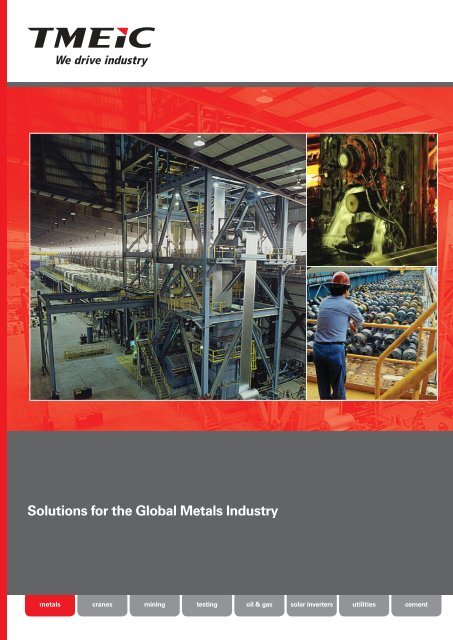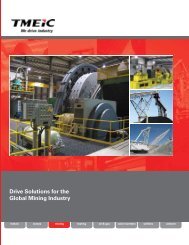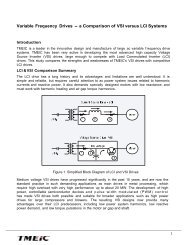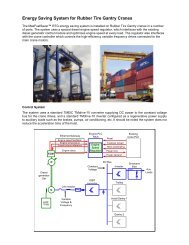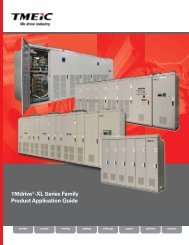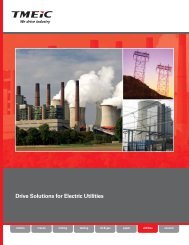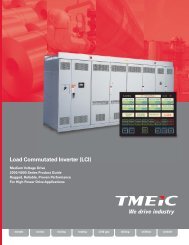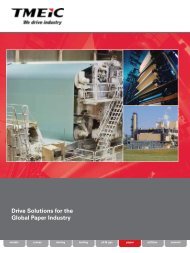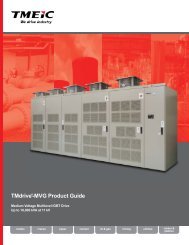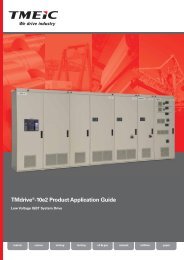Solutions for the Metals Industry A4 - Tmeic.com
Solutions for the Metals Industry A4 - Tmeic.com
Solutions for the Metals Industry A4 - Tmeic.com
- No tags were found...
Create successful ePaper yourself
Turn your PDF publications into a flip-book with our unique Google optimized e-Paper software.
Why Our Systems Set Production RecordsThe advanced features of <strong>the</strong> TMEIC automationsystem allow operation of <strong>the</strong> mill at a higher rate,often setting production records. In addition, weproduce higher quality product, based on <strong>the</strong> superiorcontrol features and physical models developed byour experienced metals engineering team. The mainfactors providing this superior mill per<strong>for</strong>mance areoutlined below.System Features and BenefitsSuperior Control Features Result in Higher ThroughputThe metals engineering team has developed advanced control schemes <strong>for</strong> mill operationsresulting in higher mill speeds and <strong>the</strong> setting of production records.Q rad Q convAccurate Physical Models Result in a Higher Quality ProductAccurate level 2 models based on <strong>the</strong> physical processes in <strong>the</strong> rolling operation, use advancedtechniques such as finite element analysis. Models cover heat transfer, plastic de<strong>for</strong>mation, mill<strong>for</strong>ce, and mill setup, resulting in improved control and higher quality product.The Engineering Team is World ClassThe metals engineering team has many years of mill experience and has built this extensiveknow-how into <strong>the</strong> automation system and <strong>the</strong> system engineering process.The Commissioning Engineers Know <strong>the</strong> <strong>Metals</strong> <strong>Industry</strong>The <strong>com</strong>missioning engineers have years of experience in <strong>the</strong> mills and are familiar with <strong>the</strong> millmachinery and <strong>the</strong> variable speed drive systems used in automation.Micro-Tracking Allows Higher SpeedsData on <strong>the</strong> micro-tracking list is ga<strong>the</strong>red and tracked at a periodic interval of approximately 25mm, or a fixed time, resulting in better control accuracy and improved product quality.Simple, Scalable, Open Architecture Brings Lower Cost of OwnershipThe open control architecture uses standard controllers, <strong>com</strong>puters, software, and <strong>com</strong>municationinterfaces, allowing easy expansion with additional <strong>com</strong>mercially available hardware andsoftware, resulting in a lower system life-time costs.S S S Fewer Sensors Reduce CostsUsing advanced control features, <strong>the</strong> system requires fewer sensors, resulting in lower initialcost and life-time maintenance cost, with an increase in ROI.+X_Unified Engineering Tools Simplify MaintenanceUnified engineering tools <strong>for</strong> configuring and tuning drives and controllers result in faster<strong>com</strong>missioning and simplified maintenance.Robust System Diagnostics Increases AvailabilityIn-depth system diagnostics built into <strong>the</strong> engineering tools, along with <strong>the</strong> option to use remotediagnostic services, increase system availability.© 2011 Toshiba Mitsubishi-Electric Industrial Systems Corporation, Japan. All Rights Reserved.Page 3 of 40
Total <strong>Solutions</strong> <strong>for</strong> Mill AutomationHot Mills Page 7Advanced Control Features Section Page• Shape setup• Object orientedsoftware design andprogramming• Highly integrated level1 & 2• Automatic gage control• Eccentricity control• Automatic profile &flatness control• Flying gage change(FGC)• Slab sizing press setup• Dual mode rolling setup(austenitic and ferritic)• Dual mill mode setup(Semi-continuous & batchoperation)• Lubricated rolling• Material propertiesprediction• Ultra-light gage modeling• Thermo-mechanicalrolling• Plate pattern optimization• Dual phase/Interruptedcooling• Piece sample tracking• Fast FM thread• Multi-mode coilingcontrolCaster & FurnaceControl .......................7Slab Sizing Press &Roughing Mill ............8Edge & Bar InductionHeaters ......................9Finishing Mill ........... 10Coiling TemperatureControl ..................... 11Coiler Control ..........12Steckel Mill ..............13Flying Gage Change 14Material PropertiesPrediction System ...15Cold Mills Page 16Advanced Control Features Section Page• Cold mill setup• Shape setup• Object-oriented level 2 design and programming• Highly integrated level 1 and 2• Automatic gage control• Eccentricity control• Automatic profile and flatness control• Flying gage change (FGC)• Differential tension controlFast & EffectiveLevel 1 Controls ......16Integrating Models<strong>for</strong> Superior Control 17Process Lines Page 18Advanced Control Features Section Page• Product tracking• Weld/seam tracking• Heated/tail tracking <strong>for</strong> entry/exit automation• Minimum tension control• Maximum tension control• Optimized bridle load distribution• Elongation control (leveler & skin pass mills)• Loss <strong>com</strong>pensation• Position control• Line setup• Setpoint distribution• Data acquisition• Open loop feed-<strong>for</strong>ward tension controlTMEIC’s Approach toProcess LineAutomation .............18Designing <strong>the</strong> StripTransport ControlSystem ..................... 19Implementing <strong>the</strong> OpenLoop Feed-ForwardControl ..................... 19Page 4 of 40© 2011 Toshiba Mitsubishi-Electric Industrial Systems Corporation, Japan. All Rights Reserved.
Total <strong>Solutions</strong> <strong>for</strong> Mill AutomationLong Products Page 20Advanced Control Features Section Page• Product tracking• Mill pacing• Flexible rolling & coolingschedules• Roll & bearingmanagement• Minimum tension control• Accurate shear control• Cascade speed controlRod Mills:• Sizing block control• Precision laying headcontrol• No Twist Mill controlSection Mills:• Saw managementsystemsRod Mills ..................20Section Mills ............21Product Tracking &Machine Monitoring 21Modernization Page 225DCS networkTM-DC DigitalinterfaceFront End (DFE)Innovation ControllerHMIDMC or Series Six4Master ControllerI/O6CPL or Series Six I/O BusSiltron SiltronSiltronHardwiredoperatordevicesTouchMMMScreen123TM-DC ModuleAssemblyTM-SeriesAC DriveAdvanced Control System Upgrades Section PageTMEIC’s control system is a scalable, open architecturereadily allowing future expansion and modernization.Legacy mill control systems are easily upgraded to <strong>the</strong>latest hardware and software.1970’s LegacySystem .....................22Early 1980’sLegacy System ........23Late 1980’sLegacy System ........24Early 1990’sLegacy System ........25Non-TMEIC System 26Services Page 27World Class Mill Automation Section Page• World-class process and automation specialists <strong>for</strong><strong>the</strong> metal rolling and metal strip processing industries• Years of experience• Broad process knowledge• Project management skills.• Engineering team is supported by world-class<strong>com</strong>missioning and field service personnel.Engineering Team ...27Technical Proposal ..28Design andProcurement ............29Factory SystemTest 30SystemCommissioning, .....32Training & Documentation32Maintenance &Service .....................33Products Page 35Products Section PageThe family of drives covers <strong>the</strong> power and supply voltagerequirements <strong>for</strong> new and legacy systems.Panel-mounted touch stations, pulpit HMIs, and level 1and 2 system software provide <strong>for</strong> all operator and controlneeds.AC/DC SystemDrives .......................35Operator Interfaces .36Software Toolsand Utilities .............37Mill Level 2 andModels .....................39© 2011 Toshiba Mitsubishi-Electric Industrial Systems Corporation, Japan. All Rights Reserved.Page 5 of 40
Hot MillsTMEIC has many firsts in hot mill automation, including <strong>the</strong> first use of all AC main drives, <strong>the</strong> first <strong>com</strong>puter-basedhot mill setup, and <strong>the</strong> first and only implementation of semi-continuous rolling in a hot mill. Our Team has installedover 140 major beam, plate, and hot mill systems worldwide. This section discusses TMEIC’s advanced hot mill controlsystem.Caster & Furnace ControlCaster control includes precise mold level control and close drive coordination <strong>for</strong> varioustypes of casting machines. Several furnace control functions are closely coordinated tomaximize production, and minimize fuel consumption and <strong>the</strong> <strong>for</strong>mation of scale on <strong>the</strong> slab.Slab Sizing Press & Roughing MillThe slab sizing press tailors <strong>the</strong> width of each slab, and <strong>the</strong> roughing mills reduce <strong>the</strong> thicknessto <strong>the</strong> particular order, based on inputs from <strong>the</strong> roughing mill models.Edge & Bar Induction HeatersThe edge heater and <strong>the</strong> bar heater produce a uni<strong>for</strong>m temperature across and along <strong>the</strong> barbe<strong>for</strong>e it enters <strong>the</strong> finishing mill.Finishing MillThe bar’s identity, temperature, thickness, and width are sent via <strong>the</strong> finish mill trackingfunction to setup models, which calculate a set of references <strong>for</strong> <strong>the</strong> control functions.Coiling Temperature ControlTo produce required mechanical properties, such as tensile strength and elongation, <strong>the</strong> rateof cooling and final temperature of <strong>the</strong> strip as it enters <strong>the</strong> coilers is precisely controlled.Coiler ControlThe coiler setup feeds references to <strong>the</strong> master controller, which <strong>the</strong>n distributes <strong>the</strong>m to <strong>the</strong>appropriate coiler controller <strong>for</strong> application.Steckel MillControls <strong>for</strong> <strong>the</strong> Steckel coiling furnaces and rolling mill are coordinated and optimized <strong>for</strong> allpasses.Flying Gage ChangePrecise mill control allows <strong>for</strong> different product to be made continuously from one long slab.Material Properties Prediction SystemThe <strong>com</strong>puterized system improves <strong>the</strong> microstructure prediction accuracy of hot rolled steel.Page 6 of 40© 2011 Toshiba Mitsubishi-Electric Industrial Systems Corporation, Japan. All Rights Reserved.
Caster & Furnace ControlCaster ControlFurnace ControlCaster Operator’s Overview ScreenTMEIC’s automation and control of<strong>the</strong> entire hot mill starts with <strong>the</strong>business <strong>com</strong>puter download of <strong>the</strong>mill schedule <strong>for</strong> <strong>the</strong> new ladle. Theindividual caster control functionsinclude:• Ladle handling• Tundish level control• Mold level control and moldcooling• Cooling spray water flowcontrol• Coordinated drive controlincluding anti-sag feature• Width control and shearcontrol• Strand trackingFor <strong>the</strong> contents of each ladle,<strong>com</strong>plete product tracking begins,and a coordinated system ofreference distribution is carriedon to <strong>the</strong> finished coil. The datacollected and distributed includes<strong>the</strong> chemical properties of <strong>the</strong> steel,<strong>the</strong> mechanical properties, and <strong>the</strong>product dimensions.The furnaces maintain a steady delivery of temperature-controlled slabs to <strong>the</strong> mill. The main automation objectivesare to maximize production, minimize fuel consumption, and reduce scale <strong>for</strong>mation.TMEIC differentiates its furnacecontrol by integrating physicalmodels with <strong>the</strong> furnace controlfunctions. Product Data In<strong>for</strong>mation(PDI) <strong>com</strong>es from <strong>the</strong> business<strong>com</strong>puter over E<strong>the</strong>rnet.Mill Pacing FunctionLevel 2 mill pacing uses PDI dataand tracking data to calculate <strong>the</strong>optimum extraction time. It is alsocoordinated with <strong>the</strong> reheatingfurnace control (in <strong>the</strong> figure <strong>the</strong>white furnace control blocks may beprovided by <strong>the</strong> furnace OEM).BUSINESSCOMPUTERSLAB PDI DATAMODELSMILL PACINGTRACKINGFURNACEMODELSROUGHING MILLSETUPFURNACEMODELSREHEATTEMPERATUREFEEDBACKRMTEMPERATURESFEEDBACKZONETEMPERATURESCONTROLCHARGE &EXTRACTBURNER CONTROLBURNERMANAGEMENTFURNACE CONTROLZONETEMPERATURESENSORSFURNACERoughing Mill SetupLevel 2 model provides roughingmill setup data and interfaces to <strong>the</strong>furnace control.FEEDBACKPROCESSINGTIMESREHEATFURNACESENSORSROUGHINGMILLSlab TrackingLevel 2 mill tracking function is linkedto <strong>the</strong> mill tracking and pacing.SENSORSFINISHINGMILL© 2011 Toshiba Mitsubishi-Electric Industrial Systems Corporation, Japan. All Rights Reserved.Page 7 of 40
Slab Sizing Press & Roughing MillThe slab sizing press and roughing mill reduce <strong>the</strong>width and thickness of <strong>the</strong> slab in preparation <strong>for</strong><strong>the</strong> finishing mill. With a large width reduction, <strong>the</strong>slab sizing press tailors each slab to a particularorder. The roughing mill models provide <strong>the</strong> targetwidth reduction to <strong>the</strong> level 1 controller, which takeseach slab to this desired width through a series ofpress actions. The press is electrically driven by alarge medium voltage motor and drive. Hydraulicallydriven top and bottom hold down rolls preventbuckling of <strong>the</strong> slab. Width gauges at <strong>the</strong> press entryand at <strong>the</strong> roughing mill exit validate that <strong>the</strong> targetwidth is achieved. The entire process is monitored byoperators on HMI screens.Significant Improvements to Operation of <strong>the</strong> Slab Sizing Press & Roughing MillAdvanced features of <strong>the</strong> TMEIC system includeimproved caster efficiency, increased mill widthreduction capability, improved width uni<strong>for</strong>mity,and improved control tolerances. Control featuresinclude micro-tracking (fast tracking) of slab positionand speed, per<strong>for</strong>med <strong>for</strong> <strong>the</strong> position and pressureregulators.The advanced sizing press model calculations include:• Die gap calculations <strong>for</strong> <strong>the</strong> anvil control• Head, body and tail draft calculations <strong>for</strong> widthreduction• Hold down roll <strong>for</strong>ce calculations <strong>for</strong> buckleprevention• Pre<strong>for</strong>ming length calculations <strong>for</strong> <strong>the</strong> taperedsections• Table lift calculations to <strong>com</strong>pensate <strong>for</strong> increasingslab height• Slab elongation ratio and travel time calculationsSlab Sizing PressRoughing MillThe roughing mills (RM) reduce <strong>the</strong> width and thickness of <strong>the</strong> bar. They can bereversing, continuous, or a <strong>com</strong>bination of both.Roughing Mill ScreenSlab Tracking RM ModelsControl starts with <strong>the</strong> level 2 slab tracking function, directing <strong>the</strong> level 1sequencing and regulators based on which zone <strong>the</strong> slab is in. Hot metaldetectors and o<strong>the</strong>r sensors are used to define <strong>the</strong> zone transitions. Specific millreferences distributed from <strong>the</strong> tracking and set-up models include:• Horizontal roll positions, side guide positions, and RM speeds• Vertical roll positions and draft <strong>com</strong>pensations <strong>for</strong> <strong>the</strong> RM edgers• Spray selection <strong>for</strong> each of <strong>the</strong> millsDynamic References <strong>for</strong> Roughing MillAfter leaving <strong>the</strong> sizing press, <strong>the</strong> slab travels through <strong>the</strong> universal roughingmill stands where <strong>the</strong> width is fur<strong>the</strong>r controlled by <strong>the</strong> edger drafting. Prior toeach pass, <strong>the</strong> level 2 set-up model provides a new set of references to <strong>the</strong> mill.Reversing Mill ScreenLooperless Tension Control Between Close Coupled Tandem Roughing StandsClose coupled roughing stands fur<strong>the</strong>r reduce <strong>the</strong> width and thickness preparing<strong>the</strong> slab <strong>for</strong> <strong>the</strong> finishing mill stands. Low tension control is applied between <strong>the</strong>close coupled stands including coupled edgers.Page 8 of 40© 2011 Toshiba Mitsubishi-Electric Industrial Systems Corporation, Japan. All Rights Reserved.
Edge & Bar Induction HeatersInduction heating is a fast and efficient method of heating moving metal, and it has been applied to various metalprocessing lines. TMEIC has applied large capacity induction heaters to hot strip mills since 1984. They are used <strong>for</strong>edge heating and bar heating to obtain uni<strong>for</strong>m temperature be<strong>for</strong>e <strong>the</strong> bar enters <strong>the</strong> finishing mill, and have beeninstalled on many new hot strip mills in recent years.Three types of induction heaters are available:Solenoid TypeThis type has a flat heating characteristic,used in hot strip mills <strong>for</strong> bar heating.Transverse TypeThis type has a partial heating characteristicand has been used <strong>for</strong> bar center heating.C-shape Transverse TypeThis type has high heating efficiency and isused <strong>for</strong> edge heating.Solenoid Type Bar Heater- Power level: up to 9,000 kW- Inductor frequency: 1,400 Hz- Temperature rise: 40°CC-Shape Transverse Type Edge Heater- Power level: up to 4,000 kW- Inductor frequency: 300 Hz- Temperature rise: 50°CTemperature [Deg.C]1120110010801060104010201000980960BAR TEMPERATURE CURVEBAR TEMPERATURE CURVE (Hot Bar 1730 mm - 40 mm T)0 1 2 3 4 5 6 7 8 9 10 11 12 13 14 15 16 17 18DistanceAverageCenter-CenterCenter-SurfaceEdge-CenterEdge SurfaceBar Heating TemperatureSimulationBe<strong>for</strong>e <strong>the</strong> edge heaters,<strong>the</strong> temperature differentialbetween <strong>the</strong> bar edge and <strong>the</strong>center is about 50º C.After <strong>the</strong> bar heaters, <strong>the</strong>temperature differential hasbeen reduced to about 10º C.EDGE EDGEHEATER HEATER1EDGEHEATER2BARHEATER1BARHEATER2SIDE GUIDECROP SHEAR© 2011 Toshiba Mitsubishi-Electric Industrial Systems Corporation, Japan. All Rights Reserved.Page 9 of 40
Finishing MillUsers require strip with close dimensional tolerances and exact metallurgical properties. TMEIC’s control systemuses models based on physical and material behavior to set up <strong>the</strong> level 1 controls <strong>for</strong> <strong>the</strong> desired strip width, gauge,shape, tension speed, and temperature.Mill Setup Model Includes:Strip Thickness ModelThe finish mill setup modelprovides inputs to <strong>the</strong> level 1 rollgap absolute gage control.Strip Width ModelModels <strong>for</strong> exit spread, edgingdraft, and width reference provideinputs to <strong>the</strong> RM setup and level 1automatic width control.Temperature & SpeedThe temperature setup model (notillustrated here) provides inputsto <strong>the</strong> cooling spray controls and<strong>the</strong> main drive speed.Shape ModelThe shape setup model providesinputs to <strong>the</strong> level 1 automatic stripprofile control, <strong>the</strong> automatic stripflatness control, and roll shiftingusing ei<strong>the</strong>r <strong>the</strong> ContinuouslyVariable Crown or Pair Crosssystems (not illustrated here).Dual Mode Mill Setup has a<strong>com</strong>bined functionality of level2 models <strong>for</strong> finishing mills andslab setup calculations <strong>for</strong> one(batch mode) or more products(semi-continuous mode) in <strong>the</strong>slab.FM Strip Thickness (FM Models)OPERATORINPUTSDESIREDTHICKNESSMODELSHOLDINGTABLETRANSFERFM EXITVERNERFM Strip Width (RM Models)OPERATOR INPUTS: FINISH WIDTH OFFSET EDGER LOAD DISTRIBUTIONHARDNESS &DEFORMATIONFEEDBACKMASS FLOWTHICKNESSMODELSFINISH MILLTEMPERATURESETUPMODELSFINISH MILLTEMPERATURESETUPFEEDBACK FEEDBACK FEEDBACKMODELSEDGING DRAFTDISTRIBUTIONMODELSWIDTHREFERENCETEMPERATUREMODELSEXIT SPREADFEEDBACKEXIT SPREADFEEDBACKHEAD & BODYMONITORCONTROLROLL GAP &ABSOLUTEAGCCONTROLFASTADAPTIVETHREADFEEDBACKGAGEMETERTHICKNESSFEEDBACKEXIT VERNIERTemperature SetupSpeed SetupShape SetupSENSORSROLLFORCESENSORSROLL GAPSENSORSMILLSPEEDSENSORSTHICKNESSSENSORSEXITWIDTHFINISHING MILLQ radiationQ convectionCONTROLAUTOMATICWIDTHCONTROLFEEDBACKFEEDFORWARDSENSORSFORCEPROFILESENSORSWIDTHPROFILEQ radiation43210Q conductionQ conductionQ convectionSlap/Strip Heat Transfer Model <strong>for</strong> RM,FM, and Coiling Temperature ControlSetup ModelsUsing roughing mill exit data, models calculate references:• A roll gap position, speed, and roll bending reference <strong>for</strong> each stand• Tension and position references <strong>for</strong> each of <strong>the</strong> inter-stand loopers• Position references <strong>for</strong> <strong>the</strong> finishing stand side guides and roll shifting• X-Ray gauge thickness and alloy <strong>com</strong>pensation values• A reference <strong>for</strong> <strong>the</strong> bar’s exit width, gauge, and temperature• Finish mill speed-up rate and limit• A set of automatic gauge control predicted <strong>for</strong>ces and transfer functions• Inter-stand cooling spray patterns and flow references from <strong>the</strong> outputs of<strong>the</strong> temperature modelPage 10 of 40© 2011 Toshiba Mitsubishi-Electric Industrial Systems Corporation, Japan. All Rights Reserved.
Coiling Temperature ControlSteel customers today demand that mills produce specific mechanical properties <strong>for</strong> <strong>the</strong>ir products, such as yieldstrength, tensile strength, and elongation. The coiling temperature control maintains <strong>the</strong> rate of cooling and <strong>the</strong> finaltemperature (<strong>the</strong> temperature-time profile) of <strong>the</strong> strip to obtain <strong>the</strong> desired metal properties as it enters <strong>the</strong> coilers.TMEIC’s Coiling Temperature Control (CTC) features:Physics-based ModelsThe model of <strong>the</strong> cooling process generates cooling water flow setpoints, which are sent to <strong>the</strong> level 1 control toproduce <strong>the</strong> desired temperature-time profile as <strong>the</strong> strip moves toward <strong>the</strong> coilers. A process model en<strong>com</strong>passesvarious coiling temperature control strategies.Metallurgical-basedModelsThe CTC model includes<strong>the</strong> effects of <strong>the</strong> steelphase trans<strong>for</strong>mation <strong>for</strong>accurate prediction of <strong>the</strong>temperature-time profilerequired <strong>for</strong> <strong>the</strong> optimummechanical properties.MODELSSTRIP SPEEDPROFILESENSORSTRACKINGPIECE SAMPLEFEEDBACKIN-COILFEEDFORWARDMODELSCOILINGTEMPERATUREFEEDBACKIN-COILFEEDBACKFEEDBACKFEEDBACKSYSTEMPARAMETERSIN-COILFEEDFORWARDTRACKINGPIECE SAMPLEFEEDBACKIN-COILVERNIERFINISHINGSPEEDSENSORSFM EXITTEMP.INTERMEDIATECOOLING ZONES ENSORSBOTTOMPYROMODELSCOILINGTEMPERATURESENSORSBOTTOMPYROSENSORSCOILINGTEMP.MILL EXITEARLY COOLINGZONELATE COOLINGZONE - VERNIERCoiler Temperature Control SystemEarly Coiling Temperature Cooling ModelThe CTC model takes finishing mill exit speed andtemperature plus feedback from <strong>the</strong> intermediate zoneand calculates <strong>the</strong> level 1 cooling water flow setpoints<strong>for</strong> <strong>the</strong> early cooling zone to achieve <strong>the</strong> desiredquench rate and intermediate temperature.Dual Phase/Interrupted CoolingThe <strong>com</strong>bination of interrupted cooling and modelingof low target temperatures achieves specific steelstructures such as <strong>the</strong> bainitic and martensitic.Late Coiling Temperature Cooling ModelThis model takes <strong>the</strong> final and intermediatetemperatures and calculates <strong>the</strong> late (vernier) coolingflow setpoints. The coiling temperature controlmodel utilizes several techniques including feedback,feed<strong>for</strong>ward, and vernier temperature control to meet<strong>the</strong> process objectives.Details of <strong>the</strong> Coiling Temperature Control ModelThe rate of cooling, <strong>the</strong> intermediate, and final temperature,are tied to <strong>the</strong> desired mechanical properties, thus precisecooling control is critical. TMEIC’s Dual Phase Coolingmodel illustrated above is described here.EarlyCoolingDUAL PHASE COOLINGRadiationLateCooling© 2011 Toshiba Mitsubishi-Electric Industrial Systems Corporation, Japan. All Rights Reserved.Page 11 of 40
Coiler ControlCoiler technology has advancedover <strong>the</strong> last ten years bringingmany new features including:• Various coiler side guidesoperating and coiling modes• Various coiler pinch roll gapoperating and coiling modes• Various wrapper roll gapoperating and coiling modesTMEIC provides advanced level1 controls to support <strong>the</strong>se newfeatures. This page describes howa typical new automatic coileroperates. The operator HMI screenshows real time data with animatedcoiler graphics.Coiler Operator ScreenCoiler MachineCoiler Control Functions Deliver Completely Automated OperationSetup References Sent From ModelsCoiler operation starts with <strong>the</strong> associated setupfunction feeding several references to <strong>the</strong> level 1 controlpreparing <strong>for</strong> a given coil. The coiler master referencecontrol function <strong>the</strong>n distributes <strong>the</strong>se references to<strong>the</strong> appropriate coiler controller <strong>for</strong> application.Hydraulic Jump ControlInitially, <strong>the</strong> unit rolls are positioned to a pre-set gap.As <strong>the</strong> strip passes by <strong>the</strong> roll, it applies a pre-set <strong>for</strong>ce,bending it around <strong>the</strong> mandrel. To avoid marking <strong>the</strong>strip, <strong>the</strong> rolls jump clear of <strong>the</strong> strip head as it passesunder each roll. This is <strong>com</strong>monly called automaticjump control. When <strong>the</strong> strip is tight around <strong>the</strong>mandrel, <strong>the</strong> unit rolls are retracted.Tail-end Slow Down and SpottingThere is a strip position calculator and tail-end spottingfunction that calculates <strong>the</strong> position of <strong>the</strong> strip’s tailendas it progresses down <strong>the</strong> run-out tables and<strong>com</strong>putes <strong>the</strong> slow-down point <strong>for</strong> <strong>the</strong> end of <strong>the</strong> coil.Telescoping ControlAno<strong>the</strong>r function in modern coiler systems is <strong>the</strong>coil presentation or telescopicity control. This isac<strong>com</strong>plished with sophisticated multi-mode hydraulicregulators on <strong>the</strong> entry side guides and steplessmandrel expansion control.Completely Automated Coil DeliveryAt <strong>the</strong> output of <strong>the</strong> coiler control system, each of <strong>the</strong>coils is automatically:• Banded• Weighed• Inspected by <strong>the</strong> shape meter• Marked <strong>for</strong> shipmentThe overhead crane <strong>the</strong>n moves <strong>the</strong> finished coils to<strong>the</strong> storage area.Page 12 of 40© 2011 Toshiba Mitsubishi-Electric Industrial Systems Corporation, Japan. All Rights Reserved.
Steckel MillThe Steckel mill is a unique type of reversing rollingmill, which can roll very large slabs to produce highquality plate and strip. Furnaces on both sides of <strong>the</strong>mill provide heated space to store <strong>the</strong> increased lengthof coiled material produced during strip rolling. Thesecoiling furnaces allow <strong>for</strong> additional heat retentionand <strong>the</strong>rmal consistency in <strong>the</strong> rolled piece, which inturn produces improved uni<strong>for</strong>mity throughout <strong>the</strong>rolled product.Steckel Mill with Coiling Furnaceslocated on ei<strong>the</strong>r sideOn right - Operator’s Screenshowing:- Alarms & Manual Controlbuttons- Steckel Mill graphic- Real-time data- Screen navigation buttons at<strong>the</strong> bottomWorld Class Features of TMEIC’s Steckel Mill Control SystemTriple Adaptive ModelThe model contains three separate control setups <strong>for</strong><strong>the</strong> head, body, and tail of <strong>the</strong> slab.Wide Product RangeControls can handle rolling both plate and coilwith thicknesses from 1 mm to 70 mm, with<strong>com</strong>plex sequences and auto recovery from manualintervention.Pass to Pass AdaptationAll critical material parameters are measured and <strong>the</strong>control setup calculated <strong>for</strong> <strong>the</strong> next pass.Tapered Thickness RollingThe thickness is fully programmable so that <strong>the</strong> headand tail can be reduced to a different amount than<strong>the</strong> body. Uni<strong>for</strong>m thickness is produced in <strong>the</strong> finalpass.Absolute Hydraulic Automatic Gage ControlThe AGC works to achieve constant target thicknessand/or follow a predetermined thickness trajectory.Temperature Controlled RollingThe metal temperature is controlled so <strong>the</strong> desiredmechanical properties can be achieved.Coiling Furnace Temperature ModelThe temperature model calculates <strong>the</strong> heat transfer to<strong>the</strong> coil in <strong>the</strong> furnace.Finishing Temperature ControlThe model calculates <strong>the</strong> desired speed of each passbased on <strong>the</strong> target temperature in <strong>the</strong> coil body.Coiling Temperature ControlThe run out table sprays are controlled to produce <strong>the</strong>temperature-time profile <strong>for</strong> <strong>the</strong> desired metallurgicalproperties.© 2011 Toshiba Mitsubishi-Electric Industrial Systems Corporation, Japan. All Rights Reserved.Page 13 of 40
Flying Gage ChangeThis page gives an overview of an advanced control technology applied to hot strip mills producing light and ultralightgage strip. These mills work with long slabs and produce many coils of various thicknesses from one slab. Flyinggage change (FGC) technology is used to change <strong>the</strong> strip thickness.The diagram shows three products A, B, and Ccontinuously rolled from one slab withoutde-threading strip from <strong>the</strong> stands. In <strong>the</strong> case of ahot mill, <strong>the</strong> mill cannot be slowed down to makechanges, so FGC is a highly coordinated controlprocedure involving multiple process actuators.The first semi-continuous hot mill FGC system,implemented by TMEIC, was in 2000.CoilA-1CutPointCoilA-2CutPointCoilA-3CutPointCoilB-1CutPointCoilC-1Product A Product B Product CThe level 2 models, which control and optimize this change, as well as <strong>the</strong> mill functions affected, are shown below.TFTCCasterShearTUNNEL FURNACETEMPERATURECONTROLTunnelFurnaceCropShearFSBEdgerRTWROLLTEMPERATUREAND WEARSSUSHAPESETUPDMMSDUAL MODEMILL SETUPFDTCFINISHING DELIVERYTEMPERATURECONTROLOptional CoilerF1 F2 F3 F4 F5 F6 F7HighROTSpraysCOILINGTEMPERATURECONTROLSpeedShearCTCRotaryCoilerROTSpraysCoilerTunnel FurnaceTemperature Set-pointsExtract TimeDescale Flows SetupStand Strip exit thicknessStand SpeedMill Spray FlowsLooper TensionRoll ForceLead SpeedDual Mode MillEdge draftHead & Tail AWC ref'sRoll profile actuator positionvs. bending transfer functionsScans scheduleRoll ShiftRoll BendingRunout TablesSpray ActionsTMEIC has implemented two types of FGC:Type 1. Constant Finishing Mill Exit SpeedWith this strategy, <strong>the</strong> mill speed is raised to <strong>the</strong>target level prior to <strong>the</strong> transition, <strong>the</strong>n <strong>the</strong> gap andup-mill stand speeds are transitioned using a ramp.During <strong>the</strong> change, <strong>the</strong> looper, speed, gap, and profileadjustments are tracked and tightly controlled, and<strong>the</strong> finishing mill exit speed is held constant.Type 2. Constant Finishing Mill Exit Strip Mass FlowWith this strategy, control of strip speed at <strong>the</strong> run-outtable and exit mass flow control are required. Thegap and stand speeds are progressively transitioneddown-mill using a ramp. The looper, speed, gap, andprofile adjustments are tracked and tightly controlled,and <strong>the</strong> finishing mill entry speed is held constant.Page 14 of 40© 2011 Toshiba Mitsubishi-Electric Industrial Systems Corporation, Japan. All Rights Reserved.
Material Properties Prediction SystemMaking High-Strength Steels at Lower CostSteel researchers are continually developing high-strength rolled steels <strong>for</strong> applications such as automobile bodies.A way to predict <strong>the</strong> microstructure and mechanical properties of <strong>the</strong>se steels would allow <strong>the</strong> production of finegrain size with high strength using lower grade metal. Only small quantities of additional alloying elements wouldbe required.An integrated system <strong>com</strong>bining simulation of <strong>the</strong> hot rolling process withprediction of <strong>the</strong> microstructure of <strong>the</strong> hot rolled steel has been developedby TMEIC, enabling <strong>the</strong> development of new production processes <strong>for</strong> finegrain size steel. The system has been proven in predicting grain size.The two steel micrographs shown here illustrate coarse grain structure (lowstrength) and fine grain structure (high strength).Course GrainStructureFine GrainStructureThe Material Properties Prediction System has Two Main PartsRolling Process Modeling SystemThis system evaluates rolling <strong>for</strong>ce,torque, power, etc., using equationsmodeling <strong>the</strong> rolling process. Thecalculation uses numerical methods andis based on a specified distribution ofroll <strong>for</strong>ces and temperatures among <strong>the</strong>stands.Rolled Steel Microstructure PredictionSystemThis system per<strong>for</strong>ms metallurgicalcalculations taking into account <strong>the</strong> rollingand subsequent cooling processes. Theprocess phenomena include static anddynamic recrystallization, grain growth,and <strong>the</strong> austenite-ferrite trans<strong>for</strong>mation.Typical Prediction ResultsFinisherLaminarCoolingTransition of austenitic graindiameter with de<strong>for</strong>mation.Upper plot 850°, Lower 950°C.Transition of volume fractionin each structure withde<strong>for</strong>mation.Upper plot 850°, Lower 950°C.Temperature1050-grainCASE -B750 -grainCASE-A680880 De<strong>for</strong>med- grainFerrite+pearlite structure720640Sub- grainsin- grain Fine ferrite+pearlite structureTimeEffect of Rolling & Cooling on Grain Structure© 2011 Toshiba Mitsubishi-Electric Industrial Systems Corporation, Japan. All Rights Reserved.Page 15 of 40
Cold MillsTMEIC has automated over 100 cold mills worldwide. This vast experience includes controls <strong>for</strong> tandem mills, singleand multi-stand reversing mills, temper mills, and Sendzimir mills. TMEIC’s automation system provides superiorcontrol based on accurate process models and tightly integrated level 1 control. Some examples are illustrated here.Tandem MillSingle Stand MillFast and Effective Level 1 ControlsCoordinationCoordinated in-coil adjustments use measured andcalculated values to maintain targets.Automatic Gage ControlAutomatic Gage Control (AGC) employs mass flowcalculation, feed<strong>for</strong>ward, feedback, tension, and slip<strong>com</strong>pensation.EccentricityEccentricity control reduces <strong>the</strong> effect of backup rollirregularities on thickness using Fourier Series Analysis.Automatic Flatness ControlAdvanced data filtering, parabolic flatness control, tiltcontrol, segmented coolant spray control, and shapemaintenance.Flying Gage ChangeFast coordinated control changes minimize strip breaksand mass flow disturbances.Micro-trackingHigh-speed data acquisition and tracking allows fasterand more accurate control action.GageDeviation[um]50Last Last Stand stand Exit exit FGC taper length < 5m < 5m-5050EccentricityOutput[um]Switch EccentricityControlControloffoffThickness [um]-500 10 20 30TimeResults of Eccentricity Control Time (sec)Fast Flying Gage Change ControlPage 16 of 40© 2011 Toshiba Mitsubishi-Electric Industrial Systems Corporation, Japan. All Rights Reserved.
Integrating Models <strong>for</strong> Superior ControlTMEIC’s automation system provides superior cold mill control based on accurate level 2 process models andintegrated level 1 controls. Some process models are listed below along with <strong>the</strong> shape control block diagram.Level 2 Process Models Ensure Production of Quality ProductForce and Power ModelsForce, torque, and powermodels with <strong>the</strong> effects oftension and friction.Flow Stress ModelsFlow stress models with <strong>the</strong>material chemistry and workhardening effects on elongation.Friction ModelsCompensation <strong>for</strong> coefficient offriction variations.Strain ModelIn-coil strain distribution.Roll Wear ModelThermal and wear effects onroll diameter profile.InteractionsInteractions betweentension, <strong>for</strong>ward slip,friction, and speed.Textured RollsThe coefficient of frictioneffect of textured rolls.Product VariationsProduct dependent transferfunctions <strong>for</strong> level 1 control.De<strong>for</strong>medRollRadiusEntryThicknessEntryTensionRollRadiusMetal De<strong>for</strong>mation ModelRollForceExitThicknessNRollForceDe<strong>for</strong>mationPowerPressure due toroll-strip frictionPressure due tometal de<strong>for</strong>mationresistanceExit TensionReferences from <strong>the</strong> model provide <strong>the</strong> setup <strong>for</strong>level 1 controls, as shown in <strong>the</strong> diagram below.ShapeControlBlockDiagramOperatorRB AdjustRoll Side-ShiftPositionModelCMSetupModelThread/RunFeedbackFlatnessFeedbackType of RollBending andShiftRoll ForceRollContourModelRollWearModelRollThermalModelGround Roll CrownStack Crown VerniersStripTensionRollDeflectModelModelStripBucklingModelStrip PropertiesProfileVernierPDI EntryProfileRoll profileactuatorBucklingThresholdModelRoll GapContourPhysicalModelModelStripPhysicalModelRollGapCrownStrip Recalculation <strong>for</strong> Limit ConstraintsPass #Max/Min Roll Gap CrownsStripStrainRangePassConstraintsStrip ConstraintsPass #Per Unit Profile andStrip ConstraintsNo TensionThreadRunModelStripFlatness&ThicknessStrategy1. Run Condition2. Mill Fully Threaded3. Post Entry ThreadFlatnessRoll SensorBending &ShiftingReferencesControlClosed LoopFlatnessControl© 2011 Toshiba Mitsubishi-Electric Industrial Systems Corporation, Japan. All Rights Reserved.Page 17 of 40
Process LinesIn recent years, changes in strip processing linemechanical configurations and increasing customerexpectations <strong>for</strong> strip quality and line productivityhave <strong>com</strong>bined to create demands on <strong>the</strong> capabilitiesof electrical drive and control systems. TMEIC hasresponded with an approach that addresses <strong>the</strong>unique requirement of effective strip transport in stripprocessing line applications. The benefit to customersis a level of per<strong>for</strong>mance that can support high linespeeds and a broad range of products processed ona single line. In addition, TMEIC helps insure a levelof per<strong>for</strong>mance that eliminates strip breaks, bridleslippage, furnace necking, catenary scratching, ando<strong>the</strong>r per<strong>for</strong>mance problems that result in degradationof finished strip quality.TMEIC’s Approach to Process Line AutomationFor superior process line control, it must beunderstood that <strong>the</strong> main function of <strong>the</strong>control system is to provide effective striptransport under all line operating conditions.To achieve this, TMEIC:• Analyzes <strong>the</strong> line control in terms of <strong>the</strong>power required by <strong>the</strong> strip transportequipment, <strong>the</strong>n models <strong>the</strong> line interms of power elements:a. Power source – positive motor torqueb. Power sink – negative motor torque• Applies an understanding of <strong>the</strong> powerrequirements <strong>for</strong> each strip transportmachine to create a control system basedon a feed <strong>for</strong>ward tension referencingsystem that minimizes dependency onclosed loop regulator per<strong>for</strong>mance.ENTRY ACCUMULATORPAYOFFREELPINCH ROLL(THREAD ONLY)FLATTENER PRE-CLEANER#1 BRIDLERINSE#2 BRIDLE #3 BRIDLEKG/mm^2TENSION ZONE 1#1 BRIDLEENTRY TENSIONTENSION ZONE 2 TENSION ZONE 3#2 BRIDLEENTRY TENSION(ZONE 1 BASE)FLATTENERLOSSESCLEANINGLOSSESNORMALIZEDACCUMULATORTENSION(ZONE 2 BASE)#1 BRIDLEEXIT TENSION1/2 TOWERLOSSES1/2 TOWERLOSSES#2 BRIDLEEXIT TENSIONPROCESS TENSION(ZONE 3 BASE)PROCESSLOSSES#3 BRIDLEENTRY TENSIONCLEANINGLOSSES#3 BRIDLEEXIT TENSIONProcessing Line Tension ProfilePage 18 of 40© 2011 Toshiba Mitsubishi-Electric Industrial Systems Corporation, Japan. All Rights Reserved.
PAYOFF REELMOTOR POWER (KW)BRIDLE 1 ROLL 1MOTOR POWER (KW)BRIDLE 1 ROLL 2MOTOR POWER (KW)ACCUMULATORMOTOR POWER (KW)BRIDLE 2 ROLL 1MOTOR POWER (KW)BRIDLE 2 ROLL 2MOTOR POWER (KW)INERTIALOSSES (KW)+INERTIALOSSES (KW)INERTIA+ +LOSSES (KW)INERTIALOSSES (KW)+INERTIALOSSES (KW)+INERTIALOSSES (KW)+FRICTIONLOSSES (KW)FRICTION+LOSSES (KW)+FRICTIONLOSSES (KW)+FRICTIONLOSSES (KW)+FRICTIONLOSSES (KW)+FRICTIONLOSSES (KW)+ROLL 1 LOADCONSTANT (%)XROLL 1 LOADCONSTANT (%)XROLL 1 LOADCONSTANT (%)XROLL 2 LOADCONSTANT (%)XTENSIONPOWER (KW)TENSIONPOWER (KW)TENSIONPOWER (KW)TENSIONPOWER (KW)XLSCONSTXLSCONSTXLSCONSTXLSCONST–+ +–+ –+–ROLLS DOWNBRUSHES DOWNFLATTENERLOSSES (KG)PRECLEANERLOSSES (KG)0.5* TOWERLOSSES (KG)ZERO (KG)0.5 * TOWERLOSSES (KG)ZERO (KG)PAYOFFTENSION (KG)LS = LINE SPEED (METERS/MINUTE)ACCUMULATORTENSION (KG)LS = LINE SPEED (METERS/MINUTE)TANKTENSION (KG)Designing <strong>the</strong> Strip Transport Control SystemTMEIC executes three major steps in designing an effectivestrip transport control system:• Analyze <strong>the</strong> primary strip transport machines (reels,accumulators, and bridles) using off-line models todetermine <strong>the</strong> capacities and limitations of each.• Develop a tension profile one-line diagram to outline<strong>the</strong> requirements <strong>for</strong> tension reference distribution, loss<strong>com</strong>pensation, tension limits, and regulator configuration.• Develop a run/jog matrix showing which drive and/ordrive groups are involved in each run or jog function, <strong>the</strong>regulator configurations <strong>for</strong> each mode, and <strong>the</strong> driveloading requirements.Implementing <strong>the</strong> Open Loop Feed-Forward ControlThe feed-<strong>for</strong>ward network consists of on-line control algorithmsproviding:• Compensation <strong>for</strong> <strong>the</strong> inertia of <strong>the</strong> motors, gearboxes, anddirectly connected mechanical equipment.• Compensation <strong>for</strong> friction and windage losses of motors,gearboxes, and directly connected mechanical equipment.• Strip tension referencing to load <strong>the</strong> drives with <strong>the</strong>torques determined from line tension setpoint data andprocess loss calculations.The <strong>com</strong>plete system consists of closed loop regulators andopen loop feed-<strong>for</strong>ward elements. However, <strong>the</strong> main elementis <strong>the</strong> feed-<strong>for</strong>ward control which minimizes <strong>the</strong> need <strong>for</strong>reactive correction by <strong>the</strong> closed loop regulators. The result issuperior strip transport per<strong>for</strong>mance.ModelsOff-lineAlgorithmsOn-lineDrivesLine parametersStrip flattenersTension levelersTemper millsReduction millsSide trimmers/slittersStrip bendingCatenary tension/positionConfiguration ParametersControlTorqueBridle load distributionFriction & windage loss <strong>com</strong>pensationInertia <strong>com</strong>pensationStrip bending loss <strong>com</strong>pensationStrip catenary/position controlSide trimmer/slitter loss <strong>com</strong>pensationWeld trackingSetpoint distributionAutomation System Delivers Significant Customer BenefitsTMEIC’s advanced process line controls have been applied to metal processing lines with excellent results. Ourexperience includes controls <strong>for</strong> galvanizing lines, pickle lines, tinning lines, coating, and painting lines. Actualsystem operation and line per<strong>for</strong>mance data obtained from operating mills have demonstrated <strong>the</strong> followingcustomer benefits:• Reduced operator intervention• Zero product quality degradation• Maximized line throughput and uptime• Maximized product capacity• Seamless product transitions© 2011 Toshiba Mitsubishi-Electric Industrial Systems Corporation, Japan. All Rights Reserved.Page 19 of 40
Long ProductsRod MillsTMEIC has extensive experience automating rod millsworldwide. Our advanced rod mill control system providescustomers with many advantages including:Looperless Minimum Tension ControlLow tension is obtained using predictive control by measuringtorque and controlling stand speed, with upstream standsunder cascade control. Tension-free rolling is achievedbetween mill sections to assure safe rolling and closetolerance to bar geometry.Precision Laying Head ControlPrecision control and coordination of <strong>the</strong> pinch roll and layinghead <strong>com</strong>bination provides <strong>the</strong> highest quality rings from millequipment.The Latest Drive TechnologyThe medium voltage TMdrive-70, employed <strong>for</strong> <strong>the</strong> no-twistblock, uses IEGTs in <strong>the</strong> converter and inverter. These providehigh reliability, low voltage gating losses, and high-speedswitching <strong>for</strong> fast drive response.A Fully Integrated Automation SystemThe architecture <strong>com</strong>bines level 1 and 2 control and dataacquisition in one easily expandable system.Mill ExperienceIn-depth mill engineering experience and field servicecapability, is available worldwide.Rod MillsHigh Speed Rod and Bar TechnologyMorgan Construction Company, USAProduct Tracking and Machine Monitoring through <strong>the</strong> Rod MillThe automation system tracks billets from <strong>the</strong> furnace, through <strong>the</strong> rolling stands, cooling bed, no-twist block, andshears, to <strong>the</strong> finished coils. This product data is sent to <strong>the</strong> level 1 controls at each stage of <strong>the</strong> process. Real-timeprocess data is immediately available to <strong>the</strong> operators in <strong>the</strong> various sections of <strong>the</strong> mill. The HMI screen below isan example of an operator’s screen <strong>for</strong> a mill section showing <strong>the</strong> drive current, rod velocity, and reduction <strong>for</strong> eachstand, as well as navigation buttons to access o<strong>the</strong>r screens.Roughing StandsIntermediate StandsFinishing StandsRod SizingNo Twist BlockCooling BedLaying HeadTypical Operator’s Screen <strong>for</strong> Roughing Mill SectionTypical Rod Mill showing Product Flow and Operator StationsPage 20 of 40© 2011 Toshiba Mitsubishi-Electric Industrial Systems Corporation, Japan. All Rights Reserved.
Section MillsTMEIC has automated many beam mills around <strong>the</strong> world using its advanced mill control system. This system providesmany advantages:Minimum Tension ControlLow tension is obtained using predictive control by measuring torque and controlling stand speed, with upstream standsunder cascade control. Tension-free rolling is achieved between mill sections to assure safe rolling and close shapetolerance.Precision Shear CuttingHigh-speed control of <strong>the</strong> shear blades and accurate timesynchronization to line speed provides exact beam lengths.Latest Drive TechnologyThe medium voltage TMdrive-30, employed <strong>for</strong> many mill applications,uses IGBTs in <strong>the</strong> PWM inverter, with high-speed switching <strong>for</strong> fastdrive response, and heat pipe cooling to provide high reliability.Fully Integrated Automation SystemThe universal control architecture <strong>com</strong>bines level 1 and 2 control,product tracking, and data acquisition in one easily expandablesystem.ExperienceWorldwide mill engineering experience and field service capability areavailable wherever your mill is located.Diagram of H-Beam Finishing MillProduct Tracking and Machine Monitoring throughout <strong>the</strong> MillThe stored schedule from <strong>the</strong> mill <strong>com</strong>puter contains <strong>the</strong>desired beam size and length, initial setup <strong>for</strong> each stand,and <strong>the</strong> roll speeds. The automation system tracks billetsfrom <strong>the</strong> furnace, through <strong>the</strong> rolling stands and shears to<strong>the</strong> cooling bed and stacks of finished beams. This productdata is sent to <strong>the</strong> level 1 controls at each stage of <strong>the</strong>process. Real-time process data is immediately availableto <strong>the</strong> operators in <strong>the</strong> various sections of <strong>the</strong> mill bymeans of <strong>the</strong> color graphic HMI screens.SCHEDULESETUP PERBEAM SIZECONTROLSPEEDTORQUECONTROLPRECISIONCUTTINGTRACKINGMILL WIDEPER ORDERCONTROLFINISHEDLENGTHShearsMill Stands`ColdSawCooling BedSimplified Beam Mill Control SchematicStackingOperator’s Mill Drives HMI Overview Screen© 2011 Toshiba Mitsubishi-Electric Industrial Systems Corporation, Japan. All Rights Reserved.Page 21 of 40
ModernizationWhen it’s time to modernize existing drives and control systems, TMEIC has <strong>the</strong> technology and project engineeringteam to assure a smooth migration path. The following pages chronicle <strong>the</strong> system architectures implemented and <strong>the</strong>opportunities <strong>for</strong> modernization.1970’s Legacy System Architecture561423Item Equipment Notes Benefits123456Drive Modernization- Modernize Siltrol drives with <strong>the</strong> TMdrive-DC orTM-Series AC drives. The DC modernization canoccur at one of three levels:• Digital Front End (DFE)• Panel with DFE• Complete drive replacement- Both <strong>the</strong> TMdrive-DC and TM-Series AC drives canbe controlled from I/O or one of several local areanetworks (ISBus, Profibus-DP, DeviceNet,TOSLINE-S20)- Configuration from <strong>the</strong> ToolboxMaster Control Modernization- Replace <strong>the</strong> electromechanical relay and TTL logicwith a new Controller & I/O- The VME rack allows a wide variety of third-partymodules to interface with virtually any industrialLANColor Touch Screen Operator Interface- Graphical touch screens <strong>for</strong> operator control of <strong>the</strong>drives- Hardwired-like per<strong>for</strong>mance using a high-speedE<strong>the</strong>rnet <strong>com</strong>munications linkHuman Machine Interface (HMI)- Graphical overview of drive system status anddiagnostic in<strong>for</strong>mation- Integral historian provides flight recorder-likefunctionality- More precise and consistent control with <strong>the</strong> digitalregulators- The local area network interface between <strong>the</strong>drives and master control provides <strong>for</strong> an accuratespeed reference distribution to <strong>the</strong> drives- With <strong>the</strong> TM-Series AC and TMdrive-DC drivessharing <strong>com</strong>mon control hardware <strong>com</strong>ponents,spare part costs are minimized in AC-DC hybridsystems- Digital solid state electronics are far more reliableand precise than electromechanical relay and TTLlogic- The open architecture of a VME rack provides aseamless interface with <strong>the</strong> rest of <strong>the</strong> controlsystem- Vast improvement in flexibility of <strong>the</strong> design,allowing <strong>the</strong> interface to evolve without impactinghardware- Diagnostic data <strong>for</strong> process operation and drivestatus- Intuitive interface <strong>for</strong> system status and diagnostictools- Historian provides powerful insight into processeventsPage 22 of 40© 2011 Toshiba Mitsubishi-Electric Industrial Systems Corporation, Japan. All Rights Reserved.
Early 1980’s Legacy System ArchitectureController641523Item Equipment Notes Benefits123Drive Modernization- Modernize Siltron drives with <strong>the</strong> TMdrive-DC orTM-Series AC drives. The DC modernization canoccur at one of three levels:• Digital Front End (DFE)• Panel with DFE• Complete drive replacement- Both <strong>the</strong> TMdrive-DC and TM-Series AC drivescan be controlled from I/O or one of severallocal area networks (ISBus, Profibus-DP,DeviceNet, TOSLINE-S20)- Control can operate with a digital tachometer orwithout a tachometer- Configuration of <strong>the</strong> control from <strong>the</strong> Toolbox- Siltron drives transitioned to AC technologywill eliminate <strong>the</strong> periodic expense of DC motormaintenance- Drives modernized with TM-DC controls providemore precise control and improved diagnosticdata- With <strong>the</strong> TM-Series AC and TM-DC sharing<strong>com</strong>mon control hardware <strong>com</strong>ponents, sparepart costs are minimized in AC-DC hybridsystems456Master Control Modernization- Replace <strong>the</strong> dated Series Six and/or DMC witha new Controller & associated I/O- The VME rack allows wide variety of third-partymodules to interface with virtually any industriallocal area network- Controller is programmed in function blocklanguage using <strong>the</strong> ToolboxColor Touch Screen Operator Interface- Graphical touch screens <strong>for</strong> operator control of<strong>the</strong> drives- Hardwired-like per<strong>for</strong>mance using a high-speedE<strong>the</strong>rnet <strong>com</strong>munications linkHuman Machine Interface (HMI)- Graphical overview of drive system status anddiagnostic in<strong>for</strong>mation- Integral historian provides flight recorder-likefunctionality- Open architecture of VME rack provides aseamless interface with <strong>the</strong> rest of <strong>the</strong> existingcontrol system- The Toolbox provides a <strong>com</strong>mon application <strong>for</strong>both <strong>the</strong> controller and all of TMEIC’s systemdrives- Vast improvement in flexibility of <strong>the</strong> design,allowing <strong>the</strong> interface to evolve withoutimpacting hardware- Diagnostic data <strong>for</strong> both process operation anddrive status- Intuitive interface <strong>for</strong> system status anddiagnostic tools- Historian provides powerful insight into processevents© 2011 Toshiba Mitsubishi-Electric Industrial Systems Corporation, Japan. All Rights Reserved.Page 23 of 40
Late 1980’s Legacy System ArchitectureHMIDCS networkinterfaceControllerTM-DC DFEDigital Front EndTM-DCModuleAssembly4DMC & Series SixMaster Controller6I/OCSF & C-Bus15HardwiredoperatordevicesDC300SiltronSilco2TM-SeriesAC DriveTouchScreenMMM3Item Equipment Notes Benefits123456Drive Modernization- Modernize DC300, Siltron, and SILCO driveswith <strong>the</strong> TMdrive-DC or TM-Series AC drives.The DC modernization can occur at one of threelevels:• Digital Front End (DFE)• Panel with DFE• Complete drive replacement- Both <strong>the</strong> TMdrive-DC and TM-Series AC drivescan be controlled from I/O or one of several localarea networks (ISBus, Profibus-DP, DeviceNet,TOSLINE-S20)- Control can operate with or without a digitaltachometer- Configuration of <strong>the</strong> control from <strong>the</strong> ToolboxMaster Control Modernization- Replace <strong>the</strong> dated Series Six or DMC with a newController and associated I/O- The VME rack allows wide variety of third-partymodules to interface with virtually any industriallocal area network- Controller is programmed in function blocklanguage using <strong>the</strong> ToolboxColor Touch Screen Operator Interface- Graphical touch screens <strong>for</strong> operator control of<strong>the</strong> drives- Hardwired-like per<strong>for</strong>mance using a high-speedE<strong>the</strong>rnet <strong>com</strong>munications linkHuman Machine Interface (HMI)- Graphical overview of drive system status anddiagnostic in<strong>for</strong>mation- Integral historian provides flight recorder-likefunctionality- DC300, Siltron, and SILCO drives transitionedto AC technology will eliminate <strong>the</strong> periodicexpense of DC motor maintenance- Drives modernized with TMdrive-DC controlsprovide more precise control and improveddiagnostic data- With <strong>the</strong> TM-Series AC and TMdrive-DC drivessharing <strong>com</strong>mon control hardware <strong>com</strong>ponents,spare part costs are minimized in AC-DC hybridsystems- Open architecture of VME rack provides aseamless interface with <strong>the</strong> rest of <strong>the</strong> existingcontrol system- The Toolbox provides a <strong>com</strong>mon application <strong>for</strong>both <strong>the</strong> controller and all of TMEIC’s systemdrives- Vast improvement in flexibility of <strong>the</strong> design,allowing <strong>the</strong> interface to evolve withoutimpacting hardware- Diagnostic data <strong>for</strong> both process operation anddrive status- Intuitive interface <strong>for</strong> system status and diagnostictools- Historian provides powerful insight into processeventsPage 24 of 40© 2011 Toshiba Mitsubishi-Electric Industrial Systems Corporation, Japan. All Rights Reserved.
Early 1990’s Legacy System ArchitectureController461523Item Equipment Notes Benefits12345Drive Modernization- Modernize your DC2000 drives with <strong>the</strong>TMdrive-DC or TM-Series AC drives. The DCmodernization can occur at one of three levels:• Digital Front End (DFE)• Panel with DFE• Complete drive replacement- Both <strong>the</strong> TMdrive-DC and TM-Series AC drivescan be controlled from one of several localarea networks (ISBus, Profibus-DP, DeviceNet,TOSLINE-S20)- Configuration of <strong>the</strong> control is from <strong>the</strong> ToolboxMaster Control Modernization- Replace <strong>the</strong> dated IOS or OC2000s with a newController and associated I/O- The VME rack allows wide variety of third partymodules to interface with virtually any industriallocal area network- Controller is programmed in function blocklanguage using <strong>the</strong> ToolboxColor Touch Screen Operator Interface- Graphical touch screens <strong>for</strong> operator control of<strong>the</strong> drives- Hardwired-like per<strong>for</strong>mance using a high-speedE<strong>the</strong>rnet <strong>com</strong>munications link- DC2000 drives transitioned to AC technologywill eliminate <strong>the</strong> periodic expense of DC motormaintenance- Drives modernized with TMdrive-DC controlsprovide more precise control and improveddiagnostic data- With <strong>the</strong> TM-Series AC and TMdrive-DC sharing<strong>com</strong>mon control hardware <strong>com</strong>ponents, sparepart costs are minimized in AC-DC hybridsystems- Open architecture of VME rack provides aseamless interface with <strong>the</strong> rest of <strong>the</strong> existingcontrol system- The Toolbox provides a <strong>com</strong>mon application<strong>for</strong> both <strong>the</strong> controller and all of TMEIC’s systemdrives- Vast improvement in flexibility of <strong>the</strong> design,allowing <strong>the</strong> interface to evolve withoutimpacting hardware- Diagnostic data <strong>for</strong> both process operation anddrive status6Human Machine Interface (HMI)- Graphical overview of drive system status anddiagnostic in<strong>for</strong>mation- Integral historian provides flight recorder-likefunctionality- Intuitive interface <strong>for</strong> system status anddiagnostic tools- Historian provides powerful insight into processevents© 2011 Toshiba Mitsubishi-Electric Industrial Systems Corporation, Japan. All Rights Reserved.Page 25 of 40
Non-TMEIC System ArchitectureLevel 2ControlL2TouchScrTouchScr eeneen TouchScreenHMIViewerWorkStationControllerO<strong>the</strong>rControllersNew Control network3New EquipmentHMIBridgeControllerFiberOpticLinkFullControlNew I/OControllerFiberOpticLinkNo Control(SignalsMapping)New I/OControllerFiberOpticLink2DRVDRVDRVTMdrive®TMdriveTMdriveOld Equipment- System “S”PartialControlControllerNo Control(SignalsMapping)ControllerOld System NetworkFullControlController4Old I/ODRIVEA VOld I/ODRIVEDRIVEA VA VOld I/O1The modernization or replacement of an old controlsystem supplied by ano<strong>the</strong>r vendor presents animplementation challenge. The replacement projecthas to minimize:• Additional shutdown periods• Post-switchover production disturbances• Installation <strong>com</strong>plexity and costDue to in<strong>com</strong>patibility of old networks and <strong>com</strong>ponents,<strong>the</strong> standard approach is to install a <strong>com</strong>plete newsystem, remove <strong>the</strong> old one, and execute <strong>the</strong> switchoverin one big step.This requires an extended shutdown period andintroduces significant risks because all system levelsmust be started and tuned up at <strong>the</strong> same time. A wayof minimizing risk is to connect all <strong>the</strong> new I/O in parallelwith <strong>the</strong> existing I/O, but this is very costly due to <strong>the</strong>additional engineering and installation materials andlabor.TMEIC’s approach to <strong>the</strong>se problems uses connectivityto <strong>the</strong> old system <strong>com</strong>ponents and a step-by-step controltakeover. The figure above shows an intermediate stagein an implementation.Approach to Replacement of System “S”Item1234Equipment NotesEstablish Controller Connectivity- Install interface boards in <strong>the</strong> old controllers; (<strong>the</strong>se may be two types, <strong>for</strong> example MultiBus I and II)- Install matching interface boards in <strong>the</strong> new controllers (VME rack) and establish <strong>the</strong> data exchangeusing fast fiber optic links (with some o<strong>the</strong>r vendors’ systems, DECNET <strong>com</strong>munication may be used <strong>for</strong>data exchange)- Map <strong>the</strong> data to and from <strong>the</strong> old system to and from <strong>the</strong> new global control networkNew HMI System- The new HMIs and level 2 <strong>com</strong>puters are easily implemented and are initially tested in passive mode,<strong>the</strong>n switched to bidirectional data flow (with o<strong>the</strong>r vendors’ systems, <strong>the</strong> new level 2 <strong>com</strong>puter acts as<strong>the</strong> <strong>com</strong>munication gateway, both <strong>for</strong> HMI and level 1 control)Drive Modernization- The new drives are installed and connected to <strong>the</strong> new controller. In <strong>the</strong> initial stage, <strong>the</strong> new controller onlyacts as a drive bridge since <strong>the</strong> old controller is still in active operation- In some cases <strong>the</strong> old drives temporarily run with <strong>the</strong> new controller. In this case, <strong>the</strong> old controller justbidirectionally maps all drive and I/O signals to <strong>the</strong> new controller (with o<strong>the</strong>r vendors’ systems, some of <strong>the</strong>old controllers and drives may be retained and kept active, and may <strong>com</strong>municate through <strong>the</strong> level 2 gatewayto <strong>the</strong> HMIs)- By switching over small sections of I/O and associated functionality during brief shutdowns, no productionstoppages or interruptions are introducedPage 26 of 40© 2011 Toshiba Mitsubishi-Electric Industrial Systems Corporation, Japan. All Rights Reserved.
ServicesTMEIC’s <strong>Metals</strong> Engineering Team in VirginiaDedicated <strong>Metals</strong> Engineering TeamThe metals engineering team is dedicated to <strong>the</strong> industry. Many of <strong>the</strong> metals engineers have over 30 years ofmill and control system experience. This background, <strong>com</strong>bined with state-of-<strong>the</strong>-art technology, enables TMEIC toconsistently meet <strong>the</strong> demanding requirements of <strong>the</strong> metals industry.Our experienced mill application engineers jointly define <strong>the</strong> equipment and control strategy with our customer’sengineers. This is followed by detailed design of <strong>the</strong> operator stations, and configuration of <strong>the</strong> drives, <strong>the</strong> millmodels, and <strong>the</strong> controllers. The phases of <strong>the</strong> project engineering work are illustrated below. Success is guaranteedby close coordination between <strong>the</strong> factory team, <strong>the</strong> customer team, and <strong>the</strong> field engineering team as indicated by<strong>the</strong> icons in <strong>the</strong> diagram.TechnicalProposalSpecificationCustomer TeamSystem FunctionalSpecification+ Customer ReviewDetailedSoftwareDesignFactoryAcceptanceTestSystemCommissioningSystemMaintenanceandServiceField TeamFactory TeamDetailedHardwareDesignSystemComponentProcurementTraining Team© 2011 Toshiba Mitsubishi-Electric Industrial Systems Corporation, Japan. All Rights Reserved.Page 27 of 40
Technical Proposal and Functional SpecificationDuring <strong>the</strong> planning stage of <strong>the</strong> project,experienced application engineers preparea technical proposal that includes:ONLINE DATAGATHERINGPRIMARY & SECONDARYLEVEL-2 COMPUTER • Customized system architecture <strong>for</strong>your project• Detailed equipment specificationsINFORMATION LANCONTROL LAN• Formal bid documentationREMOTEI/OENTRYPLCREMOTEI/OCENTER 1PLCREMOTEI/OCENTER 2PLCREMOTEI/ODELIVERYPLCSpecificationsOur application engineers are highlyqualified <strong>for</strong> this proposal work, and manyof <strong>the</strong>m have over 30 years of metalsindustry experience. In addition, <strong>the</strong>yare actively involved in industry technicalorganizations, in which <strong>the</strong>y author papersand conduct training seminars at various<strong>for</strong>ums, <strong>for</strong> example:• IEEE – Institute of Electrical & ElectronicsEngineers• AIST – Association <strong>for</strong> Iron & SteelTechnology• China International Steel CongressAfter project approval, our application engineers prepare a systemfunctional specification that includes:• Customized system architecture with an electromechanical one-linediagram <strong>for</strong> your project• Detailed equipment specification:- Motors- Drives- Controllers- I/O devices and modules• Complete operational descriptionTo ensure we meet your requirements, a thorough review of <strong>the</strong>specification is held with your project team.Page 28 of 40© 2011 Toshiba Mitsubishi-Electric Industrial Systems Corporation, Japan. All Rights Reserved.
Detailed Hardware/Software Design & ProcurementBased on <strong>the</strong> functional specification,<strong>the</strong> project engineering team proceedswith four main tasks:Software DesignControl engineers use tool and utilitysoftware to configure <strong>the</strong> level 1controller logic, sequencing, and drives.The adjacent illustration shows a typicalfunction block diagram with logic inrelay <strong>for</strong>mat. The configurations areloaded into <strong>the</strong> controllers in <strong>the</strong> testlab.Process models <strong>for</strong> each mill functionare designed, configured, and put into<strong>the</strong> level 2 <strong>com</strong>puters.Operator Screen DesignOperator interface screens are designed,configured, and loaded into <strong>the</strong> pulpitHMIs and panel mounted touch screens.Hardware DesignAll equipment is specified per <strong>the</strong>project requirements, and <strong>the</strong> powerdistribution system is designed. A<strong>com</strong>plete set of elementary diagrams,layout, and outline drawings are created.Component ProcurementTMEIC works with its manufacturingplants and vendors to provide <strong>the</strong>highest quality <strong>com</strong>ponents <strong>for</strong> yourapplication.• Drives• Motors• Controllers and I/O racks• Computers and servers• Miscellaneous mechanical andelectrical equipmentEquipment Drawing, Toolbox Screen, and Operator Screen© 2011 Toshiba Mitsubishi-Electric Industrial Systems Corporation, Japan. All Rights Reserved.Page 29 of 40
Factory System TestA thorough integrated systemfactory test is extremely important.TMEIC has made an investmentin test technology and equipment.The TMEIC engineering teamconducts an exhaustive test in <strong>the</strong>large, fully-equipped system testlab, featuring:• Complete staging of <strong>the</strong> systemwith <strong>the</strong> controllers, servers,networks, HMI system, and alldrive controllers, which contain<strong>the</strong> controller board set, keypad,LAN interface, and I/O board.• Unique to <strong>the</strong> industry, <strong>the</strong> drivecontroller includes a motor andload simulator (refer to <strong>the</strong> nextpage <strong>for</strong> details) allowing lifelikesimulation of <strong>the</strong> mill operation.• Validation of all networkinterfaces to third-party PLCsand DCS systems.• Customer operators and <strong>the</strong>TMEIC <strong>com</strong>missioning teamare integrated into <strong>the</strong> factorytesting <strong>for</strong> training and feedback.The picture above shows one of <strong>the</strong> four test labs in our Virginia facility,which has an extensive selection of test equipment, including:• 200-plus drive controllers <strong>com</strong>prising <strong>the</strong> past 20 years of driveproducts• 64 HMI and touch-screen operator stations• 12 Innovation Series and V-Series controllersTypical Factory Test Setup in <strong>the</strong> LabControlServerHMIServerHMIOperatorTouchPanelsMasterControllerMachineControllerMachineControllerSimulatedI/ODrive Controller/SimDrive Controller/SimDrive Controller/SimMLoadMLoadMLoadMotor/Load Simulators on all TMEIC Drives (AC and DC)Page 30 of 40© 2011 Toshiba Mitsubishi-Electric Industrial Systems Corporation, Japan. All Rights Reserved.
<strong>Industry</strong> Leading Process SimulationReal-World/Mill EnvironmentFactory Test SimulationLocal Area NetworksPower BridgeMotorLocal Area NetworksDigital MotorSimulatorDrive ControllerMLoadDrive ControllerM LoadDigital LoadSimulatorPowerPowerPowerDrive Cabinet,Controller,Power Bridge,& MotorMModelLoad ModelInertia K 1dN/dtFriction K 2NWindage K 3N 2In <strong>the</strong> Mill, <strong>the</strong> AC and DC Drives Control <strong>the</strong>Speed of <strong>the</strong> Motor & Mechanical LoadEach AC drive has a controller with I/O and a gatedriver, which controls <strong>the</strong> power IGBTs in <strong>the</strong>power bridge. The power bridge generates <strong>the</strong>variable frequency AC voltage supply to <strong>the</strong> threephasemotor, controlling its speed and torque.In <strong>the</strong> case of a DC drive, <strong>the</strong> power thyristorbasedpower bridge converts <strong>the</strong> AC power to avariable DC voltage, which is applied to <strong>the</strong> motorarmature. This controls <strong>the</strong> DC motor’s speed andtorque.In <strong>the</strong> Factory System Test, <strong>the</strong> Drives Control aMotor & Mechanical SimulatorEach AC/DC drive in <strong>the</strong> system test has its owndigital motor simulator based on a dynamicma<strong>the</strong>matical model. The drives control <strong>the</strong>simulators, not real motors. All drive simulatorsare networked with <strong>the</strong> controllers and operatorstations to test <strong>the</strong> entire system in real time.Starts, stops, speed changes, response to manualinputs, LAN continuity, control interaction, anddrive configuration are all validated.This unique capability allows <strong>the</strong> entire team toobtain an intimate understanding of <strong>the</strong> systemprior to <strong>the</strong> <strong>com</strong>missioning, ensuring a smooth,on-time startup.TransportDirectorScreenMill Process SimulationProcess inputs such as sensors, pyrometers, andload cells are simulated in <strong>the</strong> lab by <strong>the</strong> TransportDirector (TD). The same TD software can be appliedlater <strong>for</strong> control of <strong>the</strong> real process.The TD can be switched “on <strong>the</strong> fly” between realand process simulation modes. This allows <strong>for</strong> veryeasy implementation of Ghost Bar rolling whereonly <strong>the</strong> real metal is simulated, while real millequipment is being controlled (moved). Ghost Barfunctionality contributes to shorter startup periods,saves possible material losses and aids in systemand mill maintenance procedures.© 2011 Toshiba Mitsubishi-Electric Industrial Systems Corporation, Japan. All Rights Reserved.Page 31 of 40
System CommissioningIn <strong>the</strong> <strong>com</strong>missioning phase, <strong>the</strong> TMEIC teamincludes <strong>the</strong> field engineers you know and trust,alongside <strong>the</strong> engineer who designed and tested<strong>the</strong> system. This overlap of teams between engineeringdesign and <strong>the</strong> site ensures a smooth andon-schedule startup.The TMEIC service engineer, who is responsible<strong>for</strong> startup and <strong>com</strong>missioning, and <strong>for</strong> any futureservice required at <strong>the</strong> site, is part of <strong>the</strong> projectteam and participates in <strong>the</strong> factory system test tobe<strong>com</strong>e familiar with <strong>the</strong> system. Commissioning issupported by TMEIC design and service engineers.Commissioning PhasesCommissioning1. Oversee Installation ofElectrical Equipment: 2. Check Out all Wiring &- Motors - Controllers Communication Links, Load- Drives - Cabling & Wiring all Software, & Commission<strong>the</strong> Drives & Motors123. Mill Section Commissioningusing Shadow testing ifnecessary4. Entire Rolling Mill ControlSystem Commissioning usingGhost Rolling if necessary34Teams InvolvedCommissioning Time LineTMEIC offers a single source <strong>for</strong> installation and <strong>com</strong>missioning. Phases 2, 3, and 4 above are <strong>com</strong>pressed by:• The exhaustive factory acceptance test that includes drives and control system functionality• Training and familiarization of <strong>the</strong> entire team with <strong>the</strong> system at <strong>the</strong> factory• Using shadow testing at <strong>the</strong> mill with system inputs (not outputs) connected to <strong>the</strong> operating plant• Using timesaving Wizards <strong>for</strong> <strong>com</strong>missioning and drive tune-up• Using ghost rolling to test <strong>the</strong> <strong>com</strong>plete control system without rolling actual productsPage 32 of 40© 2011 Toshiba Mitsubishi-Electric Industrial Systems Corporation, Japan. All Rights Reserved.
Drive Training at our Training Center or in Your FacilityCustomer engineers, maintenance and operationspersonnel are trained on <strong>the</strong> drives and controlsystem at <strong>the</strong> TMEIC Training Center in Virginia. Thisworld-class facility includes large classrooms andfully-equipped training labs.Classroom and hands-on training consists of 50%class time and 50% hands-on lab time. Topics include:• Overview of <strong>the</strong> drive system• Function of <strong>the</strong> main assemblies• Technical details of <strong>the</strong> <strong>com</strong>ponents• Drive and control system tools• System diagnostics and serviceCustomized Training at <strong>the</strong> Customer’s SiteAs an alternative to <strong>the</strong> standard factory training in Virginia, TMEIC can offer a course tailored to your project andheld at your location. In this case, a project engineer trains your operators, maintenance technicians and engineersin your facility.Complete and Detailed Drive System DocumentationTMEIC delivers <strong>com</strong>plete system documentation:• An electronic instruction book with all <strong>the</strong>prints on CD with a hyperlink index• System configuration on CD• Detailed system manual• Re<strong>com</strong>mended wiring and groundingprocedures• Renewal parts list• Standard third-party vendor documentationAt <strong>the</strong> end of <strong>the</strong> project, <strong>the</strong> system drawingsare updated to reflect <strong>the</strong> final changesHard-Copy Documentation and Electronic Insturction Book© 2011 Toshiba Mitsubishi-Electric Industrial Systems Corporation, Japan. All Rights Reserved.Page 33 of 40
Global Customer Support NetworkComprehensive technical service is provided by our Customer Support Organization, staffed by TMEIC service engineerswith offices and spare parts depots across <strong>the</strong> globe.In North and South AmericaCustomers are supported by <strong>the</strong> TMEIC servicepersonnel, design engineers and Spare Parts Depotin Virginia, and <strong>the</strong> TMEIC Factory in Japan.In EuropeTMEIC service engineers service all drive systemsin Europe, supported by <strong>the</strong> European TMEIC SpareParts Depot.In Asia and <strong>the</strong> Pacific RimTMEIC services drive systems throughout China,India and <strong>the</strong> Pacific, supported by multiple FieldEngineers, Spare Parts Depots, and <strong>the</strong> TMEICfactory in Japan.Remote Drive DiagnosticsTMEIC supports drive customers through <strong>the</strong> RemoteConnectivity Module (RCM), a remote diagnosticservice link with <strong>the</strong> TMEIC design and serviceengineers in Roanoke, Virginia. The RCM enablesseamless integration between your drives and ourengineers.Remote System DiagnosticsTMEIC’s remote system diagnostics tool, includedin level 1 software, offers a quick path to problemresolution. System faults are automatically identified,and provide an integrated view of product, processand system in<strong>for</strong>mation. TMEIC design and serviceengineers in Roanoke, Virginia, can analyze <strong>the</strong> dataand provide steps <strong>for</strong> resolution.For Service or Parts, call1-877-280-1835INTERNATIONAL:+1-540-283-201024 Hours / 7 daysRemote Diagnostic Service reduces Mean Time To Repair (MTTR)Remote diagnostic service offers protection <strong>for</strong> your investment, by reducing downtime, lowering repair costs andproviding peace of mind. Remote diagnostics requires an internet connection between your plant and TMEIC <strong>for</strong> retrievalof fault logs and files to diagnose drive or system issues.Features• Reduced downtime andMean-Time-to-Repair• Secured connection• Fault Upload UtilityBenefitsQuick support saves thousands of $ in lost productionTMEIC engineers can quickly connect to <strong>the</strong> drive and diagnose many issues ina matter of minutes.Customer-controlled accessAll remote activity is conducted with permission of <strong>the</strong> customer. Drive start/stop is not permitted remotely.Proprietary Fault Upload SoftwareHistorical drive faults are identified; TMEIC design and service engineers cananalyze <strong>the</strong> issue resulting in <strong>the</strong> fault and provide a solution.Page 34 of 40© 2011 Toshiba Mitsubishi-Electric Industrial Systems Corporation, Japan. All Rights Reserved.
ProductsA Family of AC & DC System DrivesTMdrive-10e2TMdrive-30TMdrive-70TMdrive-DCVolts3300 AC1250 ACTMdrive-30TMdrive-50TMdrive-80TMdrive-70690 AC440 ACTMdrive-10e21200 DC500 AC500 DC TMdrive-DC101001,00010,00013 134 1,34013,40020,00026,80050,00067,000kWHpFeaturesCommon Control HardwareAll TMdrive products share a <strong>com</strong>mon architecture:• Common I/O boards• Common LAN interface boards• Common front panel display and keypad optionsCommon ToolboxA <strong>com</strong>mon Windows®-based toolbox used to configureand monitor all TMEIC system drives featuring:• Integrated trending• Animated function block diagrams• Commissioning and tune-up wizardsBenefitsReduced Parts InventoryTMEIC reduces <strong>the</strong> spare parts investment with a<strong>com</strong>mon set of control hardware <strong>for</strong> all of your lowvoltage AC, medium voltage AC, and DC systemdrives.Simplified MaintenanceCommissioning and tune-up wizards ensure that<strong>the</strong> system drives are not <strong>the</strong> critical path item in<strong>the</strong> start-up. In ongoing maintenance work, <strong>the</strong>integrated trending tools provide an in-depth viewinto <strong>the</strong> regulation functions.Legacy System InterfaceTMEIC system drives integrate with legacy systemsusing:• ISBus LAN interface <strong>for</strong> Innovation Series Controllerbasedsystems• Profibus-DP and DeviceNet LAN interface boards <strong>for</strong>o<strong>the</strong>r controller-based systemsReduced EngineeringThe majority of control system projects involve some<strong>for</strong>m of modernization. The coordinated interfaces ofTMEIC systems to legacy system drives reduces <strong>the</strong>cost of engineering, <strong>com</strong>missioning, and training.© 2011 Toshiba Mitsubishi-Electric Industrial Systems Corporation, Japan. All Rights Reserved.Page 35 of 40
Operator InterfacesThe HMI provides operators, technicians, and maintenance personnel with a clear window into <strong>the</strong> operation of<strong>the</strong> mill and control system, with interactive real-time process control and drive data, plus trends <strong>for</strong> per<strong>for</strong>manceanalysis. A typical rolling mill overview screen is shown below.Indicators <strong>for</strong>Upmill EquipmentStatusAlarmsPermissiveOverrideRun GhostMode at anyTimeLooper SpeedCorrectionSensor Status,Green is NormalRunout Table SprayCooling statusPermissive Indicators,click <strong>for</strong> detail popupscreensFM ExitSpeedNavigationButtons pull upSeparate ScreensWork Roll Bendingscreen, click WRBRoll Gaps screen,click Gaps buttonRoll Speed screen,click Speed buttonTrend RecorderScreen withhigh speeddata fromprocess(every 20 ms)and drives(every 1 ms)A Panel-Mounted Local Operator Station & Centralized HMI Interface areavailableFeaturesPanel-Mounted Touch ScreenThe <strong>com</strong>pact, panel mounted touch screen providesa simple display and hardwired-like control action <strong>for</strong>operator inputs such as start and stop.Machine Permissive DiagnosticsViewing <strong>the</strong> Boolean logic permissive block displayshows <strong>the</strong> contact preventing <strong>the</strong> machine sequencing.HMI Trend RecorderHigh-speed real-time and historic data from <strong>the</strong> controlsystem and drives is available on <strong>the</strong> HMI trend screen.BenefitsConvenient, Reliable Equipment Control PanelPanel-mounted close to <strong>the</strong> mill, <strong>the</strong> touch screenprovides an intuitive display and fast operator controlaction, plus rugged construction to stand up to <strong>the</strong>mill environment.Faster Operator ResponseVisual diagnostics reduce <strong>the</strong> time to resolvepermissive logic problems and/or operator trainingissues.Convenient Drive and Process DiagnosticsThe high-resolution HMI screen trends live data from<strong>the</strong> controller and drive capture buffers <strong>for</strong> accurateprocess equipment per<strong>for</strong>mance analysis anddiagnostics.Page 36 of 40© 2011 Toshiba Mitsubishi-Electric Industrial Systems Corporation, Japan. All Rights Reserved.
nv Series ControllerThe Unified nv Series Controller‘s capabilities includehigh-speed logic, sequencing, motor speed control, andcontinuous control. High-speed I/O <strong>com</strong>municationuses <strong>the</strong> industry’s first 100 Mbps double loop network“TC-net I/O”, linking remote, field mounted I/O.The main features of this powerful controller are:• Redundant loop 100 Mbps I/O <strong>com</strong>munication• Enhanced speed by direct execution of IECstandard control languages in ASIC hardware• Higher reliability using redundant modules, anderror checking and correcting ECC memory• Gigabit supervisory control networknv Controller board, upto three per chassisSecond nv Controller TC-net 100 board E<strong>the</strong>rnet boardPower supplyThird nvControllerInput/Output LAN TC-net I/O Loop, 100 MbpsInput/Output LAN TC-net I/O Loop returnSystem Network – E<strong>the</strong>rnet, 1 GbpsControl Network TC-net 100 – Fiber-optic, 100 MbpsFeatureHigh-speed processingShort control cycleLarge program capacityHigh data capacityInterruptsMultiple controllersProgramming flexibilityMemory reliabilityDetailsBit and integer processing: 20 ns; floating point add/multiply: 120 nsThree separately scheduled periodic tasks: 0.5 ms to 1,000 msPrograms up to 256 kilo steps (instructions), up to 385 periodic programsLocal/global variables 256 K words; I/O variables 16,384 16-bit wordsTotal of 16 interrupt tasksUp to three controllers per chassis; up to 4 <strong>com</strong>munication modules; redundantcontroller and network configurations possibleFour IEC 61131-3 standard languages: LD, FBD, SFC, and STAn error-correcting ECC circuit in <strong>the</strong> internal memory of each module© 2011 Toshiba Mitsubishi-Electric Industrial Systems Corporation, Japan. All Rights Reserved.Page 37 of 40
TMdrive-Navigator - Simple Configuration and MaintenanceThe TMdrive-Navigator tool helps youmaintain TMEIC drives yourself. Engineersand technicians are empowered tounderstand how <strong>the</strong> drive works and what<strong>the</strong> drive is doing. Any user can easilyaccess current drive expertise and knowhow.Desk-top like search technology links topicalsignal lists, block diagrams, help files, productdocumentation, change history, and user notes.Windows techniques facilitate navigationwithin a drive and across <strong>the</strong> system. Thestatus of all drives is always in view.High-speed data is automatically captured andsaved in <strong>the</strong> event of a drive fault. Users mayalso capture high speed data based on <strong>the</strong>ir owntrigger conditions or per<strong>for</strong>m high resolution realtimetrending.Fault data can be automatically “pushed” to keyusers. The client-server architecture allows accessto high per<strong>for</strong>mance data from remote locations– with <strong>the</strong> same resolution as if you were in <strong>the</strong>plant.Wizards support tuning of drive functions.Live block diagrams provide a real-timegraphical view of drive functions. Functionscan be configured directly from <strong>the</strong> graphicalview. Product documentation is integratedright into <strong>the</strong> tool. Users may evencapture <strong>the</strong>ir own notes to benefit futuretroubleshooting. Compatible with:• Windows XP, Vista 7• Windows Server 2003, 2008Page 38 of 40© 2011 Toshiba Mitsubishi-Electric Industrial Systems Corporation, Japan. All Rights Reserved.
Mill Level 2 Software and ModelsLevel 2 provides ma<strong>the</strong>matical process models and <strong>the</strong> required software infrastructure <strong>for</strong> <strong>the</strong>m to function. Level2 distributes references to <strong>the</strong> level 1 controllers in a timely manner, and receives process feedbacks <strong>for</strong> modelupdates and data collection. Typical level 2 functions include:• Material tracking through process zones• Distribution of references• Process feedback scans and process setups• Production logging• Engineering logging• Per<strong>for</strong>mance classification and reportsSoftware and hardware (if necessary) is split into two basic parts: process control (executables) and data storage(databases).StatisticalAnalysis &ReportingDevelopment OfficesSimple SQLDatabaseQueriesModelTablesDBProcess HistoryDBProcess models functionality is presented in <strong>the</strong> application sections of this brochure. The following are basic and<strong>com</strong>mon features of level 2 and models software, and <strong>the</strong> customer benefits.FeaturesOpen ArchitectureThe hardware plat<strong>for</strong>m is based on industrial standards(PC servers), software plat<strong>for</strong>m C++, open <strong>com</strong>municationlinks via E<strong>the</strong>rnet, and database (MS SQL or Oracle)accessed via ODBC.Structured Software ProductsBased on OOD and OOP concepts, <strong>the</strong> suite of softwareproducts is fully configurable. The functions areconfigured <strong>for</strong> various applications, NO CODE CHANGESare required.Plat<strong>for</strong>m Independence and Distributed ComputingThe same source of software products is used <strong>for</strong> variousOS plat<strong>for</strong>ms: Windows, OVMS, or Linux. The sameapplications can run on <strong>the</strong> centralized <strong>com</strong>puter or canbe distributed onto various units as required.Customer Benefits of Level 2 Software and Models• High product quality• Low cost of system ownership• Simple maintenance and troubleshootingBenefitsScalabilityThe software products can be simply “instanced” andadded to <strong>the</strong> application software <strong>for</strong> easy expansion.Cohesion of all Control LayersThe concept of global signals (Signal Data Base) andcentral data structure definition (data Dictionary DB)simplifies <strong>the</strong> system design and maintenance.Comprehensive Analysis Tools and ReportingSystem diagnosis utilities allow monitoring ofprocess execution and detailed <strong>com</strong>municationdiagnostics. Process data can be accessed via ODBC,analyzed, and reported using standard applicationssuch as: Excel, Access, MathCAD, and Statistica.• Minimum downtime• Short system startup and tune-up• Comprehensive reporting & record keepingsystem© 2011 Toshiba Mitsubishi-Electric Industrial Systems Corporation, Japan. All Rights Reserved.Page 39 of 40
Worldwide NetworkGlobal Supplier of Drive & Automation SystemsTMEIC is built on <strong>the</strong> <strong>com</strong>bined and proud heritageof Toshiba and Mitsubishi-Electric (TMEIC) in <strong>the</strong>industrial automation, control and drive systemsbusiness. Headquartered in Roanoke, Virginia, USA,TMEIC Corporation designs, develops and engineersadvanced automation and variable frequency drivesystems.The factory <strong>for</strong> <strong>the</strong> World’s factoriesTMEIC delivers high quality advanced systems andproducts to factories worldwide, while serving as aglobal solutions partner to contribute to <strong>the</strong> growthof our customers.A Global networkTMEIC’s global business includes more than 2,200employees, with sales exceeding U.S. $2.4 billion, andspecializes in <strong>Metals</strong>, Oil & Gas, Material Handling,Utilities, Cement, Paper and o<strong>the</strong>r industrial markets.Customer ServiceWe focus on <strong>the</strong> customer, working to providesuperior products and excellent service, deliveringcustomer success every project, every time.Global Office Locations:TOSHIBA MITSUBISHI-ELECTRIC INDUSTRIAL SYSTEMSCORPORATIONMita 43 MT Bldg.13-16 Mita 3 chome, Minato-ku Tokyo108-0073 JapanTel.: +81-3-5441-3828 Fax: +81-3-5444-3820Web: www.tmeic.co.jpTMEIC CorporationOffice: 1325 Electric Road, Suite 200Roanoke, VA, United States 24018Mailing: 2060 Cook DriveSalem, VA, United States 24153Tel.: +1-540-283-2000 Fax: +1-540-283-2001Email: metals@tmeic.<strong>com</strong>Web: www.tmeic.<strong>com</strong>TMEIC Industrial Systems India Private LimitedUnit # 03-04, Third Floor,Block 2, Cyber Pearl, HITEC City, Madhapur,Hyderabad, 500081, Andhra Pradesh, IndiaTel.: +91-40-4434-0000 Fax: +91-40-4434-0034Email: inquiry_india@tmeic.<strong>com</strong>Web: www.tmeic.inTOSHIBA MITSUBISHI-ELECTRIC INDUSTRIAL SYSTEMS(Beijing) CORPORATION21/F., Building B, In.do Mansion48 Zhichunlu A, Haidian District,Beijing 100098, PRCTel.: +86 10 5873-2277 Fax: +86 10 5873-2208Email: sales@tmeic-cn.<strong>com</strong>TMEIC Europe LimitedUK (London) Tel.: +44 870 950 7220Italy (Bari) +39-080-504-6190Germany (Frankfurt) Tel: +49-6968-194722Poland (Krakow) Tel: +48-12432-3400Email: info@tmeic.euWeb: www.tmeic.<strong>com</strong>TMdrive is a registered trademark of Toshiba Mitsubishi-Electric Industrial SystemsCorporation.TMEIC is a registered trademark of Toshiba Mitsubishi-Electric Industrial SystemsCorporation.TM is a registered trademark of Toshiba Mitsubishi-Electric Industrial SystemsCorporation.All o<strong>the</strong>r products mentioned are registered trademarks and/or trademarksof <strong>the</strong>ir respective <strong>com</strong>panies.All specifications in this document are subject to change without notice. Thisbrochure is provided free of charge and without obligation to <strong>the</strong> reader or toTMEIC. TMEIC does not accept, nor imply, <strong>the</strong> acceptance of any liability withregard to <strong>the</strong> use of <strong>the</strong> in<strong>for</strong>mation provided. TMEIC provides <strong>the</strong> in<strong>for</strong>mationincluded herein as is and without warranty of any kind, express or implied,including but not limited to any implied statutory warranty of merchantability orfitness <strong>for</strong> particular purposes. The in<strong>for</strong>mation is provided solely as a generalreference to <strong>the</strong> potential benefits that may be attributable to <strong>the</strong> technologydiscussed. Individual results may vary. Independent analysis and testing of eachapplication is required to determine <strong>the</strong> results and benefits to be achieved from<strong>the</strong> technology discussed. If you have any questions regarding your projectrequirements, please contact TMEIC at 540-283-2100.© 2011 Toshiba Mitsubishi-Electric Industrial Systems Corporation, Japan.All Rights Reserved.I-1010-<strong>A4</strong>


